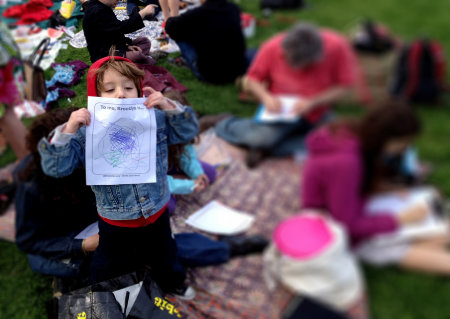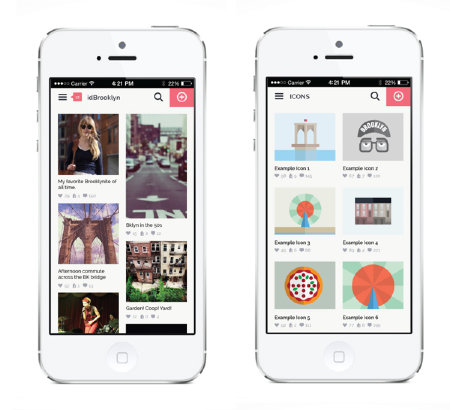As part of her thesis Sarah Lillenberg will tackle the implications of participatory design by looking at idBrooklyn, a cultural identity project. Here is her article that takes a look into idBrooklyn.
Why We’re Inviting Everyone to Help Visualize Brooklyn’s Identity

Part of what we love about Brooklyn is its “humpty-dumpty” history of cultural pioneers and makers. From Spike Lee to Woody Allen, Jay-Z to Talib Kweli, pizza slices to ramen burgers, brownstones to water towers, Jean-Michel Basquiat to Mickalene Thomas, artists in Brooklyn represent a dynamic nature that is at times too elastic for verbal explanation.
While Brooklyn’s diversity through thought, talent, and ideas are celebrated, its differences also cause a question of identity. Many people hold tightly to their Brooklyn roots and heritage. But how does Brooklyn manifest itself as a unified area with such grand diversity? Eyewitness News originally posed the question in regards to Brooklyn branding as such: “If too many people call themselves “Brooklyn,” what does “Brooklyn” mean?”
Seeking answers to the Eyewitness question, design agency imagenHB and Brooklyn-based artist/designer/writer/professor Gerardo Blumenkrantz teamed up to start a Kickstarter campaign for idBrooklyn, a cultural identity project. When approached by imagenHB, I immediately got involved with idBrooklyn as a project collaborator. The project initiators presented the idea to Brooklyn Mayor Marty Markowitz, and received a verbal endorsement.
Now successfully funded, idBrooklyn begins in one week. Phase one of the three-part project is to collect through workshops a variety of sources and mediums focusing on Brooklyn—local stories, narratives, emblems, culinary creativity, heroes, art and/or design—and create succinct visual identity icons. Currently helping idBrooklyn is Park Slope’s community organizer, Susan Fox, as well as Brooklyn’s Director of Public Events, Carolyn Grier.
In the end, the collections of idBrooklyn will produce a book of open source icons that will exist for free use within the borough. idBrooklyn will also produce an exhibition of the process, and a documentary featuring interviews with Brooklyn historians and citizens. In all of this, Brooklyn will be at the epicenter and where conversations take place. The project initiators seek no profit from the campaign or process.

While the intersection of social participation and branding may bring sweet harmonies to the ears of some contemporary designers; it may sound like sharp dissonance to others listening. This skepticism is for good reason. However, idBrooklyn is seeking to go beyond conventional branding methods, and instead, as stated in the previous article, “visualize the identity of a city through the eyes and experiences of the people.”
idBroolkyn is seeking to create more of a place-identity, that celebrates who we are as Brooklyn-dwellers. The driving questions behind this being: How do people share a group identity? How does one understand Brooklyn? And how can Brooklyn-dwellers help sustain a city’s identity that has been historically fragmentized? Following in the footsteps of narratives such as “The Four Brooklyns” by the Civilians, idBrooklyn seeks to further characterize this city.
How will these goals be realized? The project has an open structure with arranged meetings and makers workshops that engage unconventional methods of design participation and potential co-design in hopes that everyone’s voice will be heard. These workshops are meant to be experimental and re-invent themselves throughout the process according to who or how individuals engage in this co-creation. This is resonant of what Ije Nwokerie of Wolff Olins spoke about in an interview for the book Participate by Helen Armstrong and Zvezdana Stojmirovic, as “flexible branding,” which methodically leaves room for different kinds of design approaches.
Depending on how each workshop participant thinks, creates, or storytells—whether it is paint, pen, paper, ink, aerosol, song, woodwork, textiles, chalk art—these workshops are flexible. This is an open invitation to teach or learn a new skill, learn a new piece of Brooklyn information, discover a new neighborhood, or come represent one’s own. Here, idBrooklyn wants to enable all types of personal capacities by flattening the levels of hierarchy and subscribing to the ideology that ALL individuals have something to contribute to this project.

idBrooklyn also provides an app, in which Brooklynites can quickly and easily share their stories on the digital platform provided. We feel it is important that residents of Brooklyn take ownership in this creative process. Similarly, as Julia Lupton writes in Ellen Lupton’s book D.I.Y.: “When you design your own products and publications, you get to engage both creatively and critically with capital.” The opportunity to use one’s own devices to establish an identity, neighborhood, and city wields a certain amount of voice and agency that is important to recognize. The hope is that individual voices will thread together to shape a richer understanding of personage, heritage and community.
Because idBrooklyn remains flexible, the invitation for critique, or different propositions or methods is open. As an experimental project, it is important to dispel the illusion that any of the project initiators believes themselves to be expert in this process. The objective is to enjoy Brooklyn culture, learn from each other, and have fun.
– Sarah Lillenberg

idBrooklyn
As part of her thesis Sarah Lillenberg will tackle the implications of participatory design by looking at idBrooklyn, a cultural identity project. Here is her article that takes a look into idBrooklyn.
Why We’re Inviting Everyone to Help Visualize Brooklyn’s Identity
Part of what we love about Brooklyn is its “humpty-dumpty” history of cultural pioneers and makers. From Spike Lee to Woody Allen, Jay-Z to Talib Kweli, pizza slices to ramen burgers, brownstones to water towers, Jean-Michel Basquiat to Mickalene Thomas, artists in Brooklyn represent a dynamic nature that is at times too elastic for verbal explanation.
While Brooklyn’s diversity through thought, talent, and ideas are celebrated, its differences also cause a question of identity. Many people hold tightly to their Brooklyn roots and heritage. But how does Brooklyn manifest itself as a unified area with such grand diversity? Eyewitness News originally posed the question in regards to Brooklyn branding as such: “If too many people call themselves “Brooklyn,” what does “Brooklyn” mean?”
Seeking answers to the Eyewitness question, design agency imagenHB and Brooklyn-based artist/designer/writer/professor Gerardo Blumenkrantz teamed up to start a Kickstarter campaign for idBrooklyn, a cultural identity project. When approached by imagenHB, I immediately got involved with idBrooklyn as a project collaborator. The project initiators presented the idea to Brooklyn Mayor Marty Markowitz, and received a verbal endorsement.
Now successfully funded, idBrooklyn begins in one week. Phase one of the three-part project is to collect through workshops a variety of sources and mediums focusing on Brooklyn—local stories, narratives, emblems, culinary creativity, heroes, art and/or design—and create succinct visual identity icons. Currently helping idBrooklyn is Park Slope’s community organizer, Susan Fox, as well as Brooklyn’s Director of Public Events, Carolyn Grier.
In the end, the collections of idBrooklyn will produce a book of open source icons that will exist for free use within the borough. idBrooklyn will also produce an exhibition of the process, and a documentary featuring interviews with Brooklyn historians and citizens. In all of this, Brooklyn will be at the epicenter and where conversations take place. The project initiators seek no profit from the campaign or process.
While the intersection of social participation and branding may bring sweet harmonies to the ears of some contemporary designers; it may sound like sharp dissonance to others listening. This skepticism is for good reason. However, idBrooklyn is seeking to go beyond conventional branding methods, and instead, as stated in the previous article, “visualize the identity of a city through the eyes and experiences of the people.”
idBroolkyn is seeking to create more of a place-identity, that celebrates who we are as Brooklyn-dwellers. The driving questions behind this being: How do people share a group identity? How does one understand Brooklyn? And how can Brooklyn-dwellers help sustain a city’s identity that has been historically fragmentized? Following in the footsteps of narratives such as “The Four Brooklyns” by the Civilians, idBrooklyn seeks to further characterize this city.
How will these goals be realized? The project has an open structure with arranged meetings and makers workshops that engage unconventional methods of design participation and potential co-design in hopes that everyone’s voice will be heard. These workshops are meant to be experimental and re-invent themselves throughout the process according to who or how individuals engage in this co-creation. This is resonant of what Ije Nwokerie of Wolff Olins spoke about in an interview for the book Participate by Helen Armstrong and Zvezdana Stojmirovic, as “flexible branding,” which methodically leaves room for different kinds of design approaches.
Depending on how each workshop participant thinks, creates, or storytells—whether it is paint, pen, paper, ink, aerosol, song, woodwork, textiles, chalk art—these workshops are flexible. This is an open invitation to teach or learn a new skill, learn a new piece of Brooklyn information, discover a new neighborhood, or come represent one’s own. Here, idBrooklyn wants to enable all types of personal capacities by flattening the levels of hierarchy and subscribing to the ideology that ALL individuals have something to contribute to this project.
idBrooklyn also provides an app, in which Brooklynites can quickly and easily share their stories on the digital platform provided. We feel it is important that residents of Brooklyn take ownership in this creative process. Similarly, as Julia Lupton writes in Ellen Lupton’s book D.I.Y.: “When you design your own products and publications, you get to engage both creatively and critically with capital.” The opportunity to use one’s own devices to establish an identity, neighborhood, and city wields a certain amount of voice and agency that is important to recognize. The hope is that individual voices will thread together to shape a richer understanding of personage, heritage and community.
Because idBrooklyn remains flexible, the invitation for critique, or different propositions or methods is open. As an experimental project, it is important to dispel the illusion that any of the project initiators believes themselves to be expert in this process. The objective is to enjoy Brooklyn culture, learn from each other, and have fun.
– Sarah Lillenberg